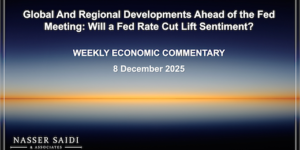Markets
Another difficult week (albeit shortened in the US due to Thanksgiving) for global equities. It started with the news of Nissan-Renault President Ghosn’s detention in Japan and continued with another prick in the tech sector bubble, and finally came the debacle in energy stocks. Hence, the S&P500 closed the week in correction territory. European bourses continued their downward trend on the back of the diatribes on the Brexit, a marked slowdown in the Eurozone economy and the EU rejection of the Italian 2019 budget. Only Japanese shares ended the week on a slightly positive note erasing almost all losses. In emerging markets, the losses were less severe than in the US and GCC markets (except the UAE) displayed decent performances. In currency markets the euro took a blow after the release of weak PMI data, while the GBP was on a rollercoaster caused by the political vagaries over the Brexit treaty. Oil prices fell below USD 60/b, the lowest in more than a year, as traders questioned whether Saudi Arabia will be able to resist the US pressure against production cuts. Furthermore, the downbeat mood was exacerbated by the slowdown in global economic growth and another unexpected large increase in US crude inventories by 4.9 mn barrels. Gold prices traded within in a narrow range to close little changed on the week.
Global Developments
US/Americas:
- The US IHS Markit composite PMI unexpectedly fell to 54.4 in Nov from 54.9 in Oct, the lowest in 2 months, as both services (54.4 from 54.8) and manufacturing (55.4 from 55.7) decelerated.
- The US Conference Board’s Leading Indicators index rose 0.1% mom in Oct after 0.6% in Sep and 0.5% in Aug. All sub-indices were in positive territory. The coincident indicator rose 0.2% mom.
- New orders for US durable manufactured goods tumbled -4.4% mom in Oct, the third decline in four months. The result was mainly driven by transportation, both defense and nondefense aircrafts which tend to be volatile. Core capital goods orders were unchanged.
- US housing starts rebounded in Oct by 1.5% mom, (-2.9% yoy). The uplift was pushed entirely by multifamily construction, while single-family starts fell for the second consecutive month.
- US existing-home sales increased 1.4% mom (-5.1% yoy) after 6 months of decline. The result was due mostly to condo/co-op homes, though also single-family sales crawled up. Three out of four census regions recorded positive sales data.
- US initial jobless claims rose by 3,000 to 224,000. The 4-week moving average rose by 2,000 to 218,500, but continuing claims fell by 2,000 to 1.668mn.
Europe:
- The IHS Markit Eurozone manufacturing PMI dropped to 51.5 in Nov from 52 in Oct, underscoring the weakest expansion since May 2016, as output advanced the least since July 2013. Export orders declined the most since survey began and job creation eased to a 22-month low.
- The Eurozone’s consumer confidence indicator slumped to -3.9 in Nov from -2.7 in Oct, the minimum since Mar 2017.
- The IHS Markit German manufacturing PMI declined to 51.6 in Nov from 52.2 in Oct, the slowest pace in manufacturing output expansion since Mar 2016.
Asia Pacific:
- Japan’s core inflation was unchanged at 1% yoy in Oct due mainly to oil and energy prices which are pushing industrial costs higher. The effects of flooding are putting pressure on fresh produce inflation.
- Japan’s trade deficit widened to JPY -449bn in Oct from a JPY 278.6bn surplus a year earlier. Imports surged the most since 2014 – as rising energy prices boosted oil imports – and exports recovered less than expected. The trade surplus with the US shrank 11% yoy to JPY 573.4bn.
Bottom line:Global financial markets are discounting a macroeconomic slowdown, caused by higher borrowing costs and the effects of the trade war. Trump’s fiscal stimulus has failed to propel the US growth rate above 4% as intended and next year its effect will fade. At the same time US inflation is on the rise since the beginning of the year. According to Gluskin Sheff’s David Rosenberg, when all major US stock indices dropped more than 10% twice in a single year, a bear market ensued. This happened in 1973, 1974, 1987, 2000, 2001, 2002 and 2008. Currently half of S&P 500 stocks are caught in a downtrend even after the post- presidential election bounce. Economic weakness is deepening especially in real estate, energy and tech. In particular, with mortgage rates at 10-year highs and home prices near at all-time records, US consumers are not keen on home purchases. Moreover, October was one of the worst months in 10 years for semiconductors, a leading indicator for technology stocks.
Regional Developments
- Bahrain’s locally listed seven retail banks posting a 14% yoy increase innet profit to USD 873mn in the Jan-Sep quarters.
- Egypt’s budget deficit in Jul-Sep 2018 (Q1 of the 2018-19 financial year) declined to 1.9% from 2% last year, according to the finance minister.
- Egypt collected EGP 6.3bn (USD 354.5mn) in taxes after the first phase of penalty exemptions (of up to 90%). The ministry of finance disclosed that more than 50,474 files were closed after reconciliation, with a total value of EGP 12.5bn.
- Remittances from Egyptians abroad increased by 20.4% yoy to USD 1.8bn in Sep, bringing the total in Jul-Sep 2018 period to USD 5.9bn (+1.5% yoy).
- Egypt sold USD 1.7bn worth of dollar-denominated treasury bills at an average yield of 3.697% last week.
- According to Egypt’s oil minister, the first auction for oil and gas drilling in the Red Sea will be launched before end of this year.
- Iraq plans to launch a reconstruction agency to focus on core projects like a deep-water port and a rail network, revealed the country’s president.
- Jordan’s Parliament passed the amended income tax law: the income thresholds and VAT exemptions were raised; those with annual income above JOD 1mn would be subject to a 35% income tax. The amended bill – expected to raise JOD 100mn instead of the JOD 290mn from the previous version – will still need to go to the upper house for approval before it is enacted as law. The PM had previously warned that rejecting the bill would push upwards the cost of servicing foreign debt – over JOD 1bn (USD 1.4bn) due in 2019.
- Inflation in Kuwait edged up by 0.18% yoy and mom in Oct; prices were mostly up, with cigarettes and tobacco recording the sharpest hike of 13.5% yoy.
- Money supply (M2) in Kuwait increased by 4.8% yoy in Sep (Aug: 4.4%) while central bank foreign assets picked up by 14.5% yoy to KWD 10.37bn.
- Kuwait’s newly launched over-the-counter market reported trading of 33,320 shares through three transactions on its first day, revealed Boursa Kuwait.
- Kuwait has reduced patent registration fees: application fees for individuals and companies is now at KWD 140 and KWD 280 respectively, while fees for publication of individual patents is KWD 175 and for companies, it is KWD 350.
- Kuwait spent over USD 60bn on development projects across various sectors including IT, communications, energy, construction and housing (to meet the Vision Kuwait 2035), according to the country’s minister of finance.
- Lebanon’s President warned that the country “no longer has the luxury of wasting time”, given the six-month stalemate in forming a government.
- Oman’s nominal GDP in Q2 grew 15.1% yoy, with the non-oil sector up by 5.1% yoy and the oil sector by 37.1%, thanks to the rebound in oil prices from USD 51.8/b in Q2 2017 to USD 63.9/b in Q2 2018.
- M2 money supply in Oman stood at OMR 16.5bn at end-Aug and grew by 2.4% yoy. M1 rose 0.3% to OMR 5.1bn. Quasi-money (saving and time deposits, certificates of deposit issued by banks, margin deposits and foreign currency denominated deposits) grew 3.4% yoy.
- Financing by Omani Islamic bank and windows rose 17.2% yoy to OMR 3.4bn at end-Aug, The total deposits at Islamic banks and windows rose to OMR 3.1bn in Aug vs OMR 2.8bn a year earlier.
- Qatar’s cabinet has reportedly approved its 2019 draft budget with allocations towards the 2022 World Cup projects. No figures were available.
- Saudi Arabia’s General Authority for Zakat and Tax called for small businesses with annual revenue between SAR 375k -1mn to register for VAT by Dec 20, 2018.
- Fitchaffirmed Saudi Arabia’s long-term foreign-currency Issuer Default Rating (IDR) at ‘A+’ with a stable outlook.
- Saudi Arabia’s Waad Al-Shamaal mining project was inaugurated last week: this is expected to boost GDP by SAR 24bn (USD 6.4bn) and non-oil GDP by around 3%.
- Smart city spending in the Middle East & Africa region is expected to double to USD 2.7bn in the next 4 years, according to KPMG. Riyadh and Dubai are the top spenders when it comes to the development of smart cities in the region.
- Investments in Fintech startups in MENA are expected to increase to AED 7.3bn in the next decade from AED 550mn in the last 10 years, according to a study by Mena Research Partners.
- Saudi Arabia and UAE announced a joint USD 500mn aid initiative to alleviate Yemen’s food crisis.
UAE Focus
- UAE Cabinet approved long-term visas for investors, entrepreneurs, specialized talents and researchers, also revealing more details about eligibility. (More: https://gulfnews.com/uae/government/uae-cabinet-approves-long-term-visa-system-1.1543068939744)
- New freelance work permits was launched by Dubai Internet City: this permit, priced at AED 7500, will allow freelancers in the technology sectors to work with multiple companies and projects. It is estimated that there are around 100k licenced freelancers paid on a short-term contract basis.
- Building licenses in Abu Dhabi increased by 23.5% yoy to 1436 in Q2 this year; residential building licenses accounted for 77.1% of the total permits issued during the quarter.
- Dubai’s Department of Economic Development added 44 new business activities across a number of sectors in the first 10 months of 2018.
- UAE’s Al Etihad Credit Bureau is planning to launch indicators specially for SMEs, to support their access to finance.
- Letters of guarantee issued in the UAE grew by 15% yoy to AED 12.7bn in Jan-Sep 2018, according to the central bank.
- The UAE hopes to resolve by next year the tariffs on aluminium and steel imposed by the US, according to the economy minister.
Media Review
Any truce between US and China in the trade will be short-lived
https://www.cnbc.com/2018/11/20/us-trade-war-with-china-wont-be-ending-anytime-soon-cnbc-cfo-survey.html
An Agenda for Resolving the US-China Conflict
https://www.project-syndicate.org/commentary/agenda-for-resolving-china-america-conflict-by-stephen-s–roach-2018-11
Oman will challenge China’s dominance in the antimony market
https://www.mining-technology.com/features/antimony-will-china-continue-control-supply/
A New Migrant Crisis for Europe?
https://carnegie-mec.org/diwan/77771
Can India afford to cool down?
https://www.wsj.com/articles/can-india-afford-to-cool-down-1542820862
Emerging markets’ currencies have staged a comeback
https://www.economist.com/finance-and-economics/2018/11/24/emerging-markets-currencies-have-staged-a-comeback
Powered by:









